Marc Quinn solo exhibition: “Held by Desire”
White Cube (50 Connaught Road, Central, Hong Kong) Nov 8, 2013–Jan 4, 2014
Marc Quinn, one of the most prominent and enduring members of the UK’s YBA Generation of artists, is having his first solo show in Hong Kong. The exhibition is a primer of Quinn’s biology-grounded practice over the last 20 years, including sculptures of a giant seashell and a polychromatic orchid, hyperrealist human irises, and an “all-over” painting of pieces of meat. Randian spoke with Marc just prior to his departing for Hong Kong.
Chris Moore: Tell us about your new work for the exhibition.
Marc Quinn: The show is called “Held by Desire” and it’s about our relationship with nature. The main work in the show, and which has the same name as the exhibition, is a brass sculpture of a bonsai tree, 1.2 meters high, and made from a scan of an actual bonsai tree in my collection. What I’m interested in with Bonsai is that it falls halfway between an artwork and a natural thing. It’s a tree that if planted in the ground would grow into a 5-meter-high Chinese juniper tree but as it is, grows in a dish and is 250 years old and is only 1.2 meters high. It seems to encapsulate our whole relationship with nature—that we try to control its nature, its shape, to our desire. And yet, of course, holding that shape is only a temporary thing. Any garden left untended will get overgrown. So it is about how we try to control nature but in the end how nature has the last word.
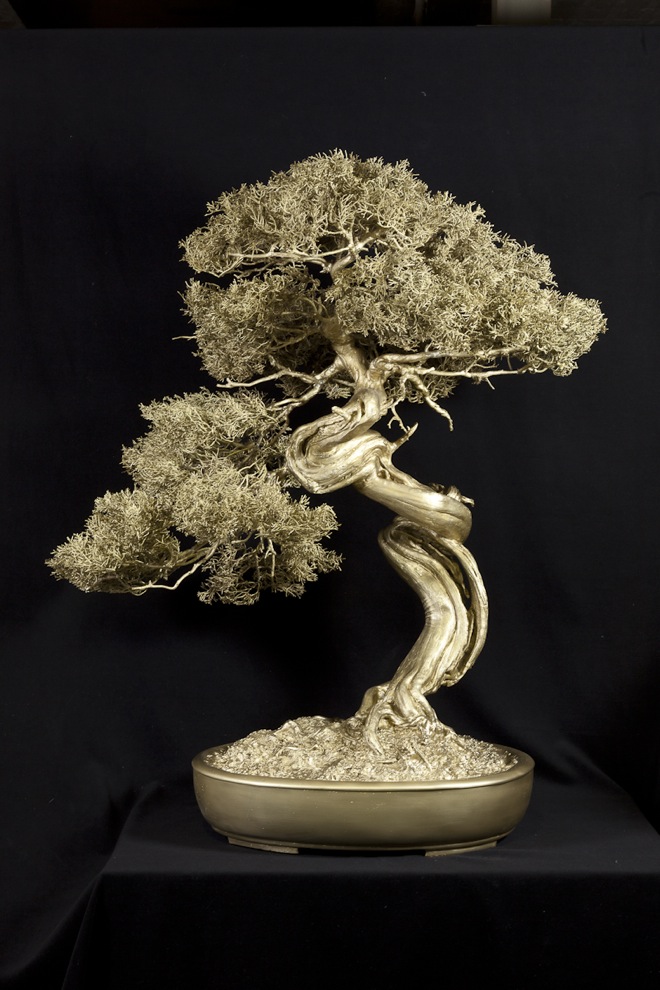
Marc Quinn,”Held by Desire (Chinese Juniper 114)”, lacquered bronze
44 7/8 x 37 13/16 x 25 9/16 in. (114 x 96 x 65 cm), 2013 (© Marc Quinn; photo: Todd-White Art Photography; courtesy White Cube)
CM: What about the photorealist seascape painting “Before and After Humans”?
MQ: It is based on photographs taken in Australia under the waves, this oceanic place where the waves crash, absent of crowds or sky. So you don’t know where the space is, whether it’s in the sky or under the water or on another planet. It’s sublime in a way, a terrible or beautiful thing—the planet before or after humans.
CM: It combines elements of photography and painting but also notions of land art, sculpture and surface.
MQ: You project yourself into it. Originally I did these underwater paintings with figures in them, with people actually at the beach swimming, and I quite liked those but then I realized when you take the figure out, you become the figure. Looking at a painting, you drift into it yourself. So it’s like the 18th century genre of the sublime, which is the idea of something beautiful and terrible, and when you experience it in a safe way, like in a painting, you can kind of enjoy the frisson of it, the frisson of your own extinction.
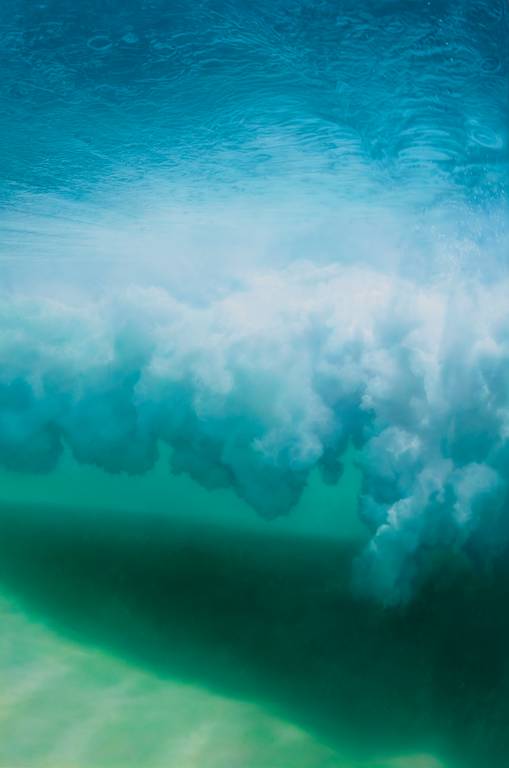
Marc Quinn, “Before and After Humans”, oil on canvas, 98 1/16 x 65 3/16 in. (249 x 165.5 cm), 2013 (© Marc Quinn; photo: Todd-White Art Photography; courtesy White Cube)
CM: This frisson applies as much to “Self” doesn’t it? [(1991–), the frozen cast of the artist’s head made from his blood]
MQ: Yes, it’s the same kind of thing—it’s an effect that I like. Art for me is concrete philosophy—making objects to help me understand what it is to be a person in the world. And because I think I am pretty much like other people, hopefully then so that other people can have an emotional connection to it as well. I’m not interested in art for its decorative qualities; I’m interested in art for its philosophical qualities. The meat paintings are a case in point, where genres meet. They look like abstract paintings in red and white, but in fact they are made of the material of figuration. They look beautiful, they also look disgusting—they are attractive/repellent. There are all these polarities, so you can never really resolve them, either in your mind or your eye – you keep on wanting to look at it. Art is [about] trying to create a situation within an image or an object that is unresolvable. Bad art is art that is resolved immediately, whereas with great art there is always an ambiguity there that keeps pulling you back.
CM: I guess the meat painting is also a still life taken to the extreme.
MQ: Yes, it’s like this tiny corner of a carcass of a Rembrandt ox made into a whole painting—“a still-life biopsy”. What is really interesting about art is how, with a piece of meat painted by Rembrandt in the 17th century and then painted by me now, the subject matter hasn’t changed, only how you look at it. What’s interesting to me is how the vision of the same thing changes.
CM: Looking back now obviously “Self” continues to influence your sculptural practice but how would you say it affects your painting practice?
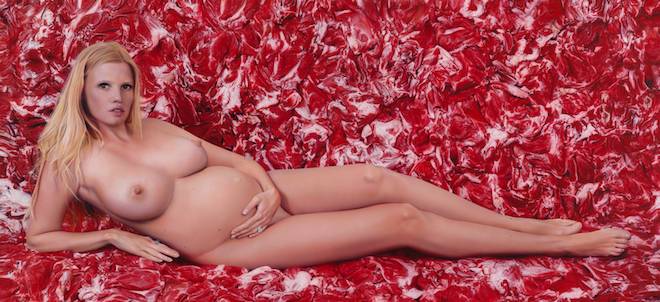
Marc Quinn, “Past, Present and Future”, oil on canvas, 47 5/8 x 101 3/16 in. (121 x 257 cm), 2013 (© Marc Quinn; photo: Todd-White Art Photography; courtesy White Cube)
MQ: Well you can look at the meat painting and the painting of Lara Stone [a model], pregnant on a bed of meat, which is in the show and is called “Past, Present and Future”, is connected to that too. In that image you have dead flesh in the meat, living flesh in her, and new life—the child—being made in her pregnant stomach. So you have the whole cycle of life. But essentially it’s an optimistic image because it’s a beautiful woman who is celebrating that cycle of life, something that can also be tragic and awful. And I think “Self’ is also essentially an optimistic sculpture because it’s a head of me, in my own blood, frozen, and I’ve made one every five years, so five of them exist, and yet I’m talking to you on the phone too, so it’s also about the miraculous power of the human body to reproduce itself as well.
CM: “Past, Present and Future” also refers to your sculpture “Alison Lapper Pregnant”.(1)
MQ: Yes and also to the reclining nudes of Manet’s “Olympia” (1863) and Titian’s “Venus of Urbino” (1538).
CM: Some of the works in the exhibition relate to China. What are the connections?
MQ: The jade eye “Towards a Map of the Universe” and the “Invention of Carving” sculpture were inspired by a trip to the Palace Museum in Taipei in January. Among the major exhibits there are a small sculpture of a piece of pork [“Meat-shaped Stone”, Ch'ing dynasty (1644-1911)], and rather beautiful jade discs—Neolithic or quite old anyway—that were seen as maps of the universe. So I made a carving in jade of a [human] iris with a map of the world on it.
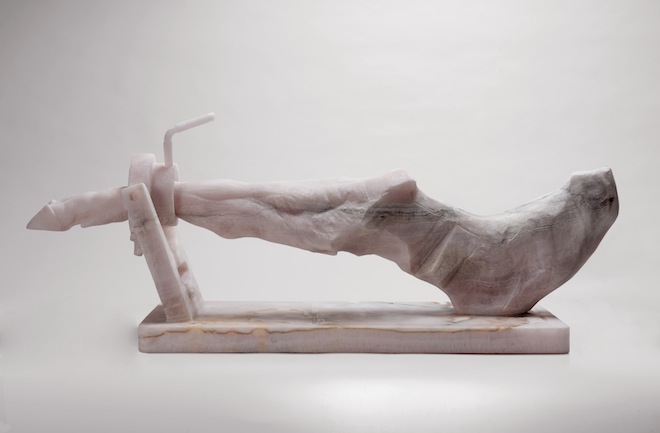
Marc Quinn, “The Invention of Carving”, marble, 15 3/4 x 46 7/8 x 11 13/16 in. (40 x 119 x 30 cm), 2013 (© Marc Quinn; photo: Marc Quinn Studio; courtesy White Cube)
CM: You made a similar disc that stands on its edge in a lake, water gushing out of it.
MQ: Yes—it’s in a river in Norway—“All Nature Flows through Us”, a portrait of the collector who commissioned it. It’s 10 meters high and water flows through the pupil of the eye. Again, it’s about our connection to nature. Which leads me to the other sculpture in the exhibition, “The Invention of Carving”, which was inspired by the pork sculpture—as a starting point—and then I went to the British Museum, where there was an exhibition about Ice Age sculpture.(2) And one of the earliest pieces [in the exhibition] was a lion carved in bone. And I wondered how do you get to carving something in bone? And I thought what happens is, first of all you carve the meat—there is a very intimate connection between sculpture and eating flesh. So I got this Serrano ham, carved the ham off the bone, and then had that re-carved in onyx—making a carving of a carving—as homage to the beginning of sculpture.
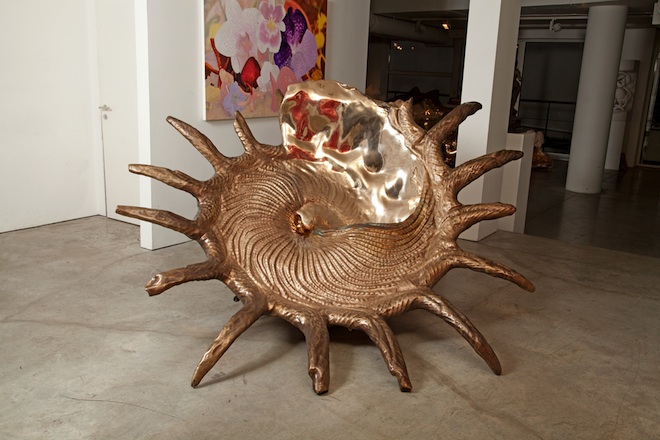
Marc Quinn, “The Architecture of Life”, bronze, 53 9/16 x 92 1/2 x 66 9/16 in. (136 x 235 x 169 cm), 2013 (© Marc Quinn; photo: Marc Quinn Studio; courtesy White Cube)
CM: Your interest in science, particularly genetics, is well known. And “The Architecture of Life”, a giant seashell, speaks directly to this, as well as your paintings and sculptures of orchids speak, but perhaps less obviously also “The Invention of Carving”, because of its references to human consumption of flesh and the social practices surrounding eating—and by inference, our evolution.
MQ: And the ritual around it, such as the use of the stand that holds the leg. But also, with the “Architecture of Life”, what I found amazing about the shells is that these beautiful, perfectly symmetrical, utterly harmonious forms, are made by tiny creatures without a brain or spinal column. It made me think, is art something we invented or did we discover it? It was in the world, and we discovered it. Shells are the first sculptures really, the archeology of sculpture.
Then I looked at it further—I loved the polished surface of the shell—and I thought, if I cast it in bronze and polished its surface to a mirror finish, I’d end up with an object that reflected the present moment in its finish. But, if you look at the size of the shell, you’ve got these circles like on a tree, baring record of the time needed for its creation. It’s as if you asked some mad scientist to design a three-dimensional model showing how the present becomes the past. It comes back to our origin and evolution. We have all come from the sea, and this is reflected even in our myths, with the birth of Venus, etc.
CM: Do you also look at Buddhism and regeneration?
MQ: Yeah, I’m not a Buddhist myself but I have a lot of Buddhist objects around the studio so that probably rubs off as well.
CM: Is contemporary art just repeating itself, endlessly remixing minimalism, pop and conceptual art? How does it reinvent itself?
MQ: Well, it can’t because the world changes. I think that’s the wrong question. The question is “can contemporary art repeat itself?” And the answer is: if you tried to repeat yourself, you couldn’t. Like Heraclitus said, you can never stand in the same river twice.
(Interview conducted by telephone on November 1, 2013)
_____________________________________
Notes
1. “Alison Lapper Pregnant” has now appeared in three installations—as a life-size marble version in London’s Trafalgar Square on the notoriously empty fourth plinth (2005-7), and as giant inflatable versions at the 2012 London Paralympic Games opening ceremony and at this year’s Venice Biennale in the piazza on the island of San Giorgio Maggiore.
2. “Ice Age art: arrival of the modern mind”, The British Museum, February 7–June 2, 2013, London. Curated by Jill Cook.



